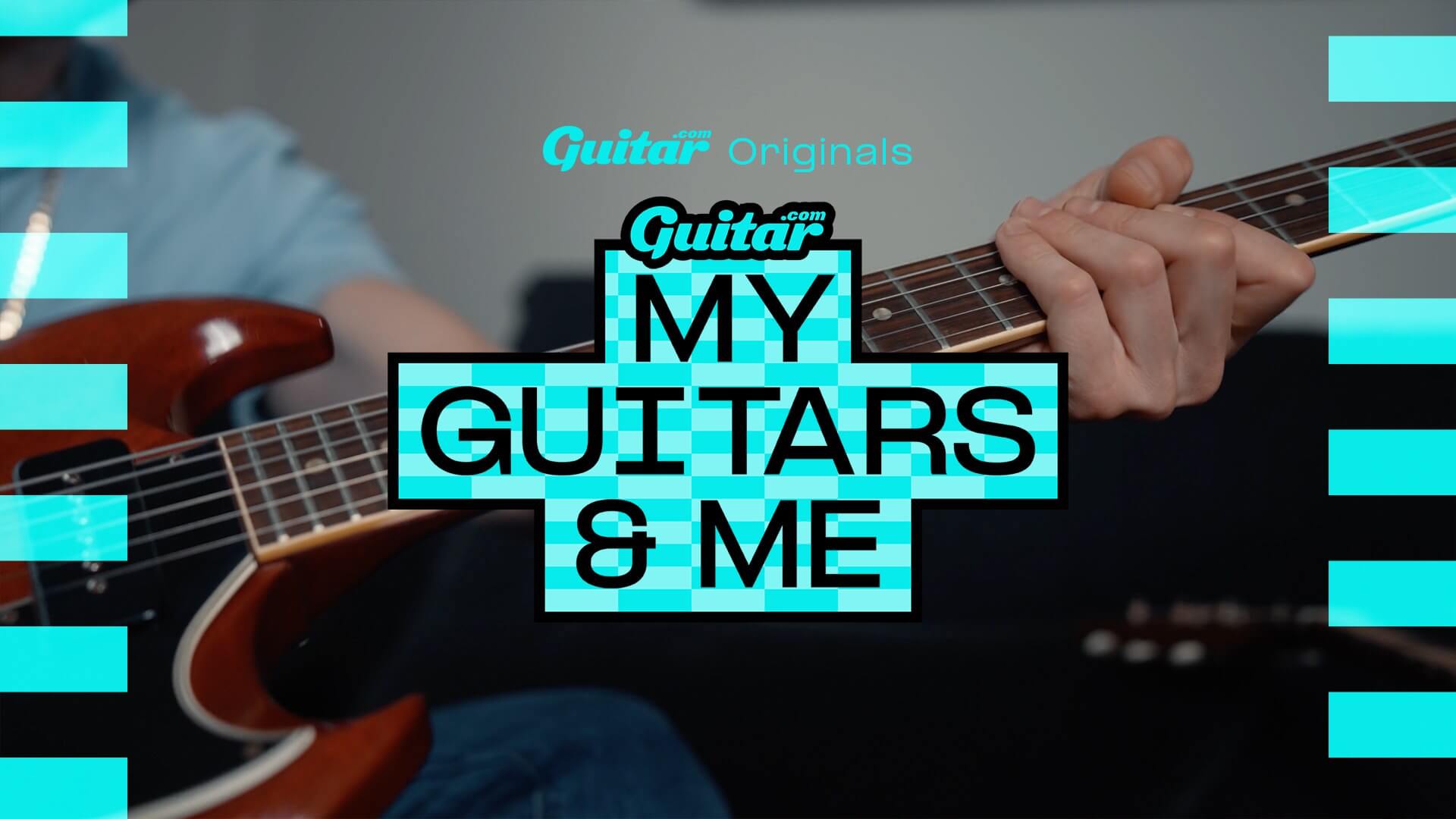How Sleater-Kinney have “embraced, protected and preserved that strangeness” for 30 years
Sleater-Kinney’s Carrie Brownstein and Corin Tucker have wrought ten new songs from the fraught, gnarly experience of death and grief for their tenth album in three decades. We sat down with the pair to talk SGs, Les Pauls, and how they’re still doing things their own way.

Sleater-Kinney. Image: Chris Hornbecker
As anyone who has experienced loss knows, grief can transform the contours of the heart so that it is more vulnerable, and there is greater capacity for desire. If you’re inclined to believe in tarot, the Angel Number 10 is symbolic of the end of one life cycle and the beginning of a new chapter. The number 10 embodies wholeness, perfection and the ripe potential for this new period of life.
That immense energy and potential sparkles within Carrie Brownstein and Corin Tucker’s 10th studio album, Little Rope, contrasted as it is with the surge of grief and fury that Brownstein was grappling with following the news that her mother and stepfather had been killed in a car accident while holidaying in Italy.
That news was a double whammy for the longtime bandmates, friends and one-time lovers. Unable to contact Brownstein, the American Embassy had phoned her emergency contact instead: Tucker. So, it was Tucker who had to convey the heartbreaking news to Brownstein in the autumn of 2022.

The age-old truth, however tragic, that great trauma leads to great art proves to be evident in Little Rope. Months and months of Brownstein’s solace-seeking in her guitar, the very physical and tactile act of putting her fingers to the fretboard and strings, finding a connection that was familiar and soothing had resulted in an urgent need to create something new, something healing and furious and authentic in its emotional rawness.
It is evening for Tucker and Brownstein when they join us on Zoom. Brownstein, a writer (Hunger Makes Me A Modern Girl, 2015), is particularly articulate in her answers. There’s a very conscious choice of words. Tucker is a little more ready to respond from the heart and gut, willing to be challenged by questions.
Brownstein says that their latest album “certainly encompassed more than one theme or motif. There’s a yearning and sense of uncertainty, restlessness and being in between joy and grief, or sitting in a space of love or falling out of love; there’s a lot of just walking on the edge. It’s not an album that only deals with loss, it deals with seeking and searching. The title – Little Rope – could be the most despairing final moment of your life or what you grab onto to save yourself. The wanting that you hear in the lyrics is about clawing your way out of your current predicament, whether personal or political or existential. Some of the songs felt hopeful, even if they didn’t necessarily sound optimistic.”
Rope Burn
From their earliest beginnings as a band, alone in a room with amps and guitars, Brownstein and Tucker have had a language of their own. With Little Rope, the duo chose to pare their creative process back to their foundations. Guitars, amps, a room, their voices, their melodies. As they discuss, it was also a long-awaited opportunity to work with a producer they’d been circling around for nearly a decade.
Bloodied, tender Little Rope is the musical equivalent of a healing wound. It’s exposed, it’s undeniable in its sensory impact, and yet — all these gnarly feelings cannot be this intense forever. Twenty-six years on from Sleater-Kinney’s third album Dig Me Out, their latest album feels like a sister to that excoriating, classic release.
Two years ago, Tucker and Brownstein released the first Sleater-Kinney album they’d self-produced, and the first without Janet Weiss since 1996. Path of Wellness felt like a rockier, grittier statement of intent following the poppier, more melodic (St. Vincent-produced) The Center Won’t Hold in 2019. Both albums, to any lifelong fans of the band, musically and energetically strayed from the snarling sassiness of late 90s Sleater-Kinney where fury, heartbreak and lust seethed through the lyrics, the tightly wound guitars, and the thundering drums.

Dig Me Out was a revelation in 1997, followed by The Hot Rock in 1999. Both were ferociously candid, as if Tucker had eschewed traditional therapy and worked her demons out in the studio in real time. There was tangible, tactile pain emanating from those albums and it didn’t feel self-indulgent; it felt vulnerable, and in its relatability, it felt inclusive.
Little Rope, drenched in grief and the immediacy of aloneness, reminds listeners how fiery the Sleater-Kinney duo remain, and how original. Brownstein’s been reflecting on the ordinariness of trauma within our everyday, living consciousness. In Hell, she portrays the infernal punishment of hell as not a place, or a singular, all-consuming experience, but elemental to our days.
“Hell is just a signpost, when you take a certain path,” she sings, “I pull myself in pieces, pull myself apart. It’s like looking in a mirror, with a stranger looking back.”
Hook Line
There’s plenty of hooky, juicy sing-along songs on Little Rope. This is a cleverly curated collection where each track drops at somewhere between 3 and 4 minutes. Like the album itself, tracks are concise and undiluted: they rollick in, grab you into their embrace with heedless intensity, then release you without warning and race out the exit before you’ve exhaled.
Tucker puts it down to reverence for albums, going back to the days of vinyl in which a long player typically fit 10 to 12 tracks, running around 40 or 50 minutes.
“I think that [curation of 10 tracks] comes from our love of the album and the art of creating an album and listening to a body of work from an artist. We wanted Little Rope to be its most impactful in a concise version.”
It is concise, but within those relatively short tracks there are concentrated layers of melody, mood and stories. Brownstein admits she had been enjoying the process of playing guitar so much that she’d written countless melodies and additional parts for songs during the process of making the album. She did so on her 1972 Gibson SG.

“I wrote a lot on my 1972 Gibson SG. It’s the guitar I’ve had the longest and there was a sense of wanting to play on something familiar. I really, really needed the playing this time. I over-wrote so many melodies and parts. I still play my Guild S-100, but I really returned to my Gibson a lot on this album.”
Tucker discovered her staple guitar through a borrowed studio model that John Goodmanson convinced her to use during the recording of Dig Me Out in 1996 at Seattle studio Stu’s Place. Brownstein later gifted Tucker a reissued 1958 Gibson Les Paul for her birthday, almost identical to the model Tucker had borrowed from Goodmanson.
Tucker says, “I usually play a Gibson Les Paul, which is a beefier rhythm guitar and it worked well to do a lot of the rhythm stuff on this record. It’s really versatile though, it can do a really pretty lead, or atmospheric textures, it’s just a well-made guitar.”

Tuning Forks
More interesting than the specific guitars Sleater-Kinney use is the way they use them.
Tucker explains, “Our sonic vernacular is a unique language that we have and we tune our guitar to C# then drop it a step and a half, which is a strange key to write in, but it makes a specific world for our songwriting that is really unique. That’s been a throughline for all of our songs through the years. It creates a specific parameter for what we can do in our songs. We experiment and bend it according to the key we’re writing in.”
That unique tuning began when Tucker was the lone guitarist in Washington punk band Heaven To Betsy alongside drummer Tracy Sawyer.
Brownstein recalls, “Corin tuned her guitar to her own voice then dropped down a bit. When we played together, we obviously needed to tune our guitars and that happened to be C#. What it does for the band is creates a sticky sourness to the notes and time, so we’re always grappling with dissonance and when we do play something that is more beautiful, it’s such a break, such a divergence from something that’s often much stranger. It’s helped create the sound of Sleater-Kinney.”

She adds, “There’s a lot that goes into Sleater-Kinney that’s unconventional. We’re self-taught, we use partial, inverted chords… We’ve embraced, protected and preserved that strangeness to Sleater-Kinney while expanding our capabilities and craftsmanship in terms of the songwriting. Sometimes we write on different instruments, but it comes back to the way the guitars relate and intertwine, that’s the fulcrum, it’s essential to the band.”
Tides of distortion, fuzz and the occasional, thrilling squall of fingers slipping across the fretboard will send a spine-tingling shiver through listeners. The tangy, fuzzy Needlessly Wild is the soundtrack to a woman losing her mind, joyfully and recklessly. A tangle of rhythm and lead guitars is sexy in its swirling climax. That’s an important element really. Little Rope is sexy, assured, authoritative.
Tucker and Brownstein deliver tight, melodic instrumentals with the sort of genuine confidence that a 20-year-old doesn’t deliver. There’s a cohesiveness to themes of final words (Say It Like You Mean It), surviving grief (Hell), seeking comfort in chaos (Needlessly Wild, Untidy Creature, Hunt You Down), and struggling with ordinary daily tasks (Dress Yourself).
There’s a swaggering, Ziggy Stardust-style pomp and ceremony to Hunt You Down with its squelchy, pulsating synth beat, bursts of whirly-gig riffs and a crooning, haunting reminder that “the things you fear you most will hunt you down…down, down, down.”
Speaking The Lingo
Tucker and Brownstein have both referred to a shared sonic vernacular, a unique language that both women have shared for decades. Both swap their roles, reading one another without needing to strategise, and that ease applies to their guitar parts.
“I’m more of a rhythm player, and Carrie is more of a lead,” says Tucker. “Most of the time we’re in those roles in a song, but there are certain times if the other person is singing that we change roles and follow the melody. We have roles we’re most comfortable in but we change as we need.”
The guitar itself had a prominent role, too. Brownstein is effusive in her passion for the guitar, her “favourite instrument”. While she’ll divert her attention to other instruments and songwriting methods, she inevitably draws back to the guitar.
“This album was written chiefly on guitar but every once in a while I’ll write on keyboard or bass, or I’ll program drums and make a strange beat, and add a bassline just so I can write some guitar. I’m always careening for guitar but sometimes I have to trick myself to get there,” says Brownstein.

“The emotionality of the guitar, the way the notes bend, the effects to distort, disintegrate, corrode the notes or make them thicker… The guitar is my favourite instrument, but sometimes I like to approach it through the side door.”
Grammy-winning producer John Congleton oversaw proceedings at Portland’s Flora Recording and Playback. Think of any of the great bands that peaked in the 90s and noughties and there’s a good chance Congleton was in the producer’s seat. From Alvvays indie-jams to Laurie Anderson’s art-rock, the savagery of Bitch Magnet to the synth-dance of Franz Ferdinand, the soaring, layered drama of Modest Mouse to the riffing goth-schlock of Marilyn Manson.
Brownstein says, “We’d talked to John in 2014 before we came back after a hiatus and made No Cities To Love. We’d had conversations for a long time. He was in a band, Paper Chase, which was on the same little indie label as we were for a long time, Kill Rock Stars. He’d done work with Sharon van Etten, Angel Olsen, and St. Vincent that we loved.
“The timing aligned for this record and I’m really glad it was the first we made with John. He has a great ear. He’s quick. He doesn’t like to labour something, he loves going hunting for tones, and he knows what’s good about our band and pushed us to get there vocally, making sure the guitar tones were perfect. But, he doesn’t mind something sounding a bit ugly sometimes, and most of all, he’s a lot of fun to work with.”
Little Rope is out 19 January on Loma Vista




